Sudoku Course:

Welcome to Course in Sudoku
Part 5
‘X-
In this part of the course we will present some more difficult methods to reduce the number of candidate digits to better solve the puzzle. For this we need the candidate table. The candidate table can be displayed by the Sudoku Instructions Program.
The methods we describe here are based on the relationship of a candidate digit with both rows and columns. They are based on pure logic.
The X-
For an X-
For swordfish and jellyfish the candidate digit in question need not be present in all the squares where the columns and rows cross each other.
The rather odd names of these methods may relate very faintly to the outline of the
involved squares with the candidate digit in question. We will understand more of
these difficult methods if we start with the simplest, namely the X-
X-
If the same candidate digit within two rows is limited to the same two columns, then
that digit must necessarily be in two of the four ‘crossing-
Since that digit can only be once in each of the two columns, the candidate digit can be removed from the two columns outside the two rows.
This method, which focuses on two times two squares, is called an X-
Either the digit should be placed as indicated by the \ part of the X or as indicated by the / part of the X. The exact place would become clear later in the solving process.
.png)
This board shows an 'X-
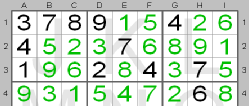 In the small picture you can see the final solution for this part of the board. In
row 2 digit 8 should be in square G2 and in row 4 digit 8 should be in square I4.
In the small picture you can see the final solution for this part of the board. In
row 2 digit 8 should be in square G2 and in row 4 digit 8 should be in square I4.
X-
If the same candidate digit within two columns is limited to the same two rows, then
that digit must necessarily be in two of the four ‘crossing-
Since that digit can only be once in each of the two rows, the candidate digit can be removed from the two rows outside the two columns.
We do not know in which two of the four ‘crossing-
.png) This board shows an 'X-
This board shows an 'X-
So, in these rows candidate digit 5 must be in columns H and I. In these rows candidate digit 5 can be removed from the other columns (shown in red).
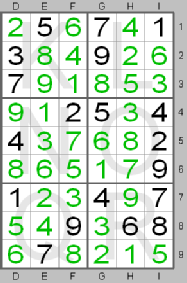 In the small picture you can see the final solution for this part of the board. In
column H digit 5 should be in square H3 and in column I digit 5 should be in square
I9.
In the small picture you can see the final solution for this part of the board. In
column H digit 5 should be in square H3 and in column I digit 5 should be in square
I9.
Swordfish -
If the same candidate digit within three rows is limited to the same three columns,
then that digit must necessarily be in three of the ‘crossing-
Since that digit can only be once in each of the three columns, the candidate digit can be removed from the three columns outside the three rows.
We do not know in which three of the ‘crossing-
.png)
This board shows a 'Swordfish' for candidate digit 2 (shown in blue), which forms a swordfish because in rows 5, 8 and 9 candidate digit 2 is only present in columns A, E and F. So, in these columns candidate digit 2 must be in rows 5, 8 and 9. Therefore in these columns candidate digit 2 can be removed from the other rows (shown in red).
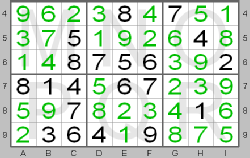 In the small picture you can see the final solution for this part of the board. digit
2 should in square A9 in column A, in square E8 in column E and in square F5 in column
F.
In the small picture you can see the final solution for this part of the board. digit
2 should in square A9 in column A, in square E8 in column E and in square F5 in column
F.
Swordfish – Columns/Rows
If the same candidate digit within three columns is limited to the same three rows,
then that digit must necessarily be in three of the ‘crossing-
Since that digit can only be once in each of the three rows, the candidate digit can be removed from the three rows outside the three columns.
We do not know in which three of the ‘crossing-
.png) This board shows a 'Swordfish' for candidate digit 8 (shown in blue), which forms
a swordfish because in columns A, C and E candidate digit 8 is only present in rows
2, 4 and 5. So, in these rows candidate digit 8 must be in columns A, C and E.
This board shows a 'Swordfish' for candidate digit 8 (shown in blue), which forms
a swordfish because in columns A, C and E candidate digit 8 is only present in rows
2, 4 and 5. So, in these rows candidate digit 8 must be in columns A, C and E.
In these rows candidate digit 8 can be removed from the other columns (shown in red).
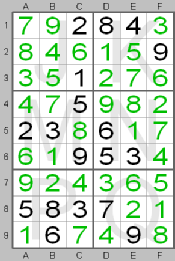 In the small picture you can see the final solution for this part of the board. digit
8 should in square A2 in column A, in square C5 in column C and in square E4 in column
E.
In the small picture you can see the final solution for this part of the board. digit
8 should in square A2 in column A, in square C5 in column C and in square E4 in column
E.
Jellyfish -
If the same candidate digit within four rows is limited to the same four columns,
then that digit must necessarily be in four of the ‘crossing-
Since that digit can only be once in each of the four columns, the candidate digit can be removed from the four columns outside the four rows.
We do not know in which four of the ‘crossing-
.png)
This board shows a 'Jellyfish' for candidate digit 2 (shown in blue), which forms a jellyfish because in rows 2, 3, 4 and 5 candidate digit 2 is only present in columns D, E, G and H. So, in these columns candidate digit 2 must be in rows 2, 3, 4 and 5.
In these columns candidate digit 2 can be removed from the other rows (shown in red).
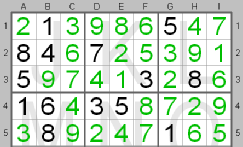 In the small picture you can see the final solution for this part of the board. digit
2 should in square D5 in column D, in square E2 in column E, in square G3 in column
G and in square H4 in column H.
In the small picture you can see the final solution for this part of the board. digit
2 should in square D5 in column D, in square E2 in column E, in square G3 in column
G and in square H4 in column H.
Jellyfish – Columns/Rows
If the same candidate digit within four columns is limited to the same four rows,
then that digit must necessarily be in four of the ‘crossing-
Since that digit can only be once in each of the four rows, the candidate digit can be removed from the four rows outside the four columns.
We do not know in which four of the ‘crossing-
.png) This board shows a 'Jellyfish' for candidate digit 8 (shown in blue), which forms
a jellyfish because in columns D, F, H, and I candidate digit 8 is only present in
rows 2, 3, 7 and 8. So, in these rows candidate digit 8 must be in columns D, F,
H and I.
This board shows a 'Jellyfish' for candidate digit 8 (shown in blue), which forms
a jellyfish because in columns D, F, H, and I candidate digit 8 is only present in
rows 2, 3, 7 and 8. So, in these rows candidate digit 8 must be in columns D, F,
H and I.
In these rows candidate digit 8 can be removed from the other columns, (shown in red).
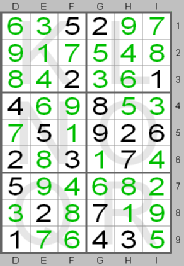 In the small picture you can see the final solution for this part of the board. digit
8 should in square D3 in column D, in square F8 in column F, in square H7 in column
H and in square I2 in column I.
In the small picture you can see the final solution for this part of the board. digit
8 should in square D3 in column D, in square F8 in column F, in square H7 in column
H and in square I2 in column I.
As you have seen these methods are not very easy to use. They need access to the
candidate table and even then it may be difficult to spot a jellyfish or a swordfish.
The X-
This program can help you to locate X-
In the beginning you can let the program find the structures and let it do the candidate removal.
Later when you get more experience you can also -
In the next and final part of the sudoku course we will present an additional method for solving even the most difficult puzzle.
Happy Sudoku Solving!
© Sudoku Instructions Programming Unit -